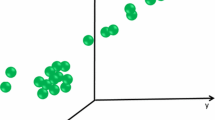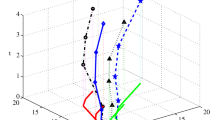Abstract
A new concept is proposed of estimating mesh similarity based on trajectory data. The model is formulated as an unsupervised learning method using a type of Gaussian process on a continuous coordinate system. This allows for the features of meshes and trajectories to be determined as the estimated latent coordinates that are different from geographic ones. The similarities of meshes and trajectories are represented through those of coordinates. In addition, this allows for easy visualisation. After introducing the coordinate estimation method with a type of Markov Chain Monte Carlo approach, the proposed method was verified using actual trajectory data from the city of Sendai, Japan.







Similar content being viewed by others
References
Giannotti, F, Nanni, M, Pinelli, F and Pedreschi, D, (2007) “Trajectory pattern mining” in Proceedings of the 13th ACM SIGKDD international conference on Knowledge discovery and data mining (San Jose, USA, 12–15 August 2007)
Monreale, A, Pinelli, F, Trasarti, R and Giannotti, F, (2009) “WhereNext: a location predictor on trajectory pattern mining” in Proceedings of the 15th ACM SIGKDD International Conference on Knowledge Discovery and Data Mining (New York, USA, 28 June-1 July, 2009)
Hoff, P., Raftery, E., Handcock, M.: Latent space approaches to social network analysis. J. Am. Stat. Assoc. 97(460), 1090–1098 (2002)
Møller, J., Syversveen, A., Waagepetersen, R.: Log gaussian cox processes. Scand. J. Stat. 25(3), 451–482 (1998)
Ishwaran, H., James, L.: Computational methods for multiplicative intensity models using weighted gamma processes: proportional hazards, marked point processes, and panel count data. J. Am. Stat. Assoc. 99(465), 175–190 (2004)
Blei, D., Ng, A., Jordan, M.: Latent dirichlet allocation. J. Mach. Learn. Res. 3, 993–1022 (2003)
Nowicki, K., Snijders, T.: Estimation and prediction for stochastic blockstructures. J. Am. Stat. Assoc. 96(455), 1077–1087 (2001)
Hasan, S., Ukkusuri, S.: Urban activity pattern classification using topic models from online geo-location data. Transportation Research Part C: Emerging Technologies. 44, 363–381 (2014)
Inagaki, K, Hara, Y and Kuwahara, M, (2016) “Latent structural analysis of a city center using the spatial and categorical co-occurrence of facilities” in Proceedings of the 13th International Conference on Design & Decision Support Systems in Architecture and Urban Planning (27–28 June 2016, Eindhoven, The Netherlands)
Mochihashi, D, Yoshii, K and Goto, M, (2013) “Modeling text through Gaussian process”, IPSJ SIG Technical Report, 2013-NL-213(11), 2013, pp. 1–8 (in Japanese)
Rasmussen, C and Williams, C, (2000) Gaussian Process for Machine Learning, The MIT Press, 2000
Gilks, W, Richardson, S and Spiegelhalter, D (Eds.), (1995) Markov chain Monte Carlo in practice, CRC Press
Acknowledgments
The data used in this work was provided by AGOOP Corp. This work was supported in part by JSPS KAKENHI Grant Number JP15K18131.
Author information
Authors and Affiliations
Corresponding author
Additional information
Publisher’s Note
Springer Nature remains neutral with regard to jurisdictional claims in published maps and institutional affiliations.
Rights and permissions
About this article
Cite this article
Nakanishi, W. Understanding and Visualisation of Geographic Mesh Similarity by Trajectory Data and Gaussian Process Modelling. Int. J. ITS Res. 18, 35–42 (2020). https://doi.org/10.1007/s13177-018-0171-9
Received:
Revised:
Accepted:
Published:
Issue Date:
DOI: https://doi.org/10.1007/s13177-018-0171-9




